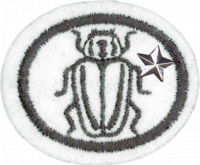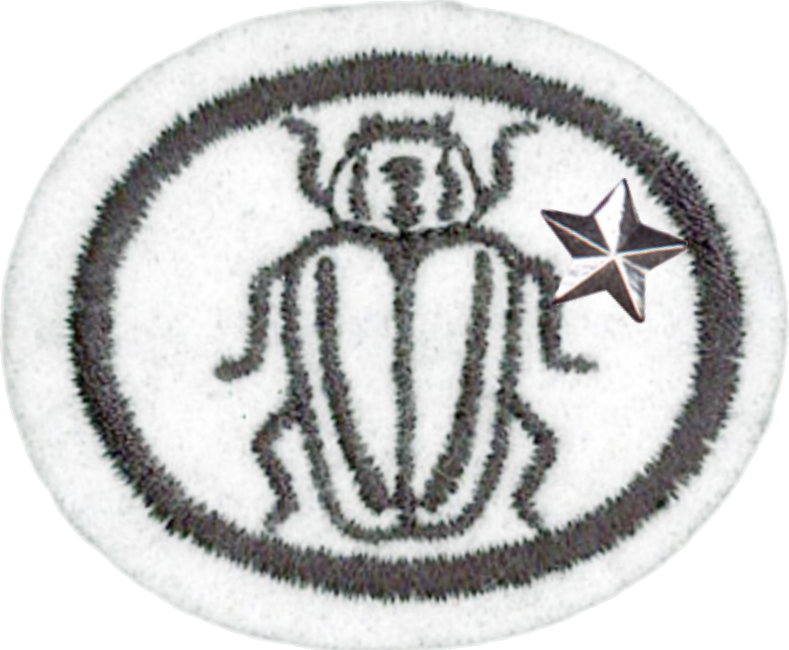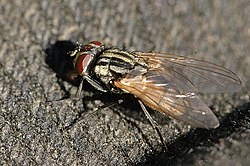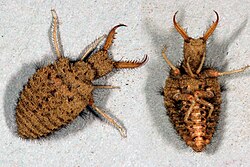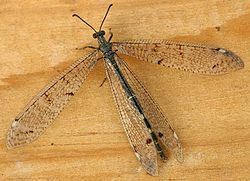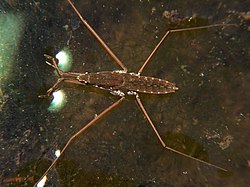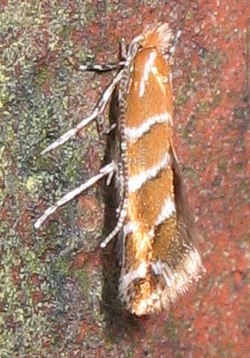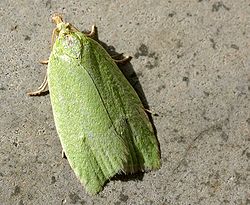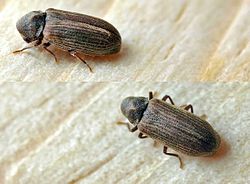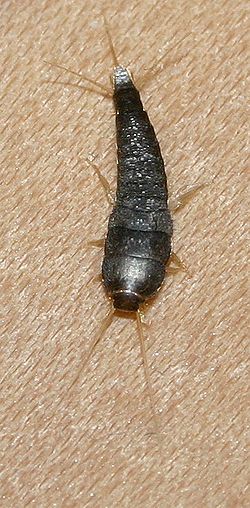AY Honor Insects - Advanced Answer Key
1
For tips and instruction see Insects.
2
- a. Add to your collection 50 species of insects representing at least ten different orders. Labels must include collector's name, date, locality, order, family, and genus or species level name. (Carelessly mounted or broken specimens are not acceptable.)
- b. Add to your colored drawings or paintings 50 species of insects, representing at least ten different orders. Drawings or paintings need to be life size or larger, to show the details of small insects, and in natural coloring. Label drawings with date, order, family, and genus or species level name.
- c. Add to your colored photographs 50 species of insects, representing at least ten different orders. All pictures are to be in focus, close-ups and properly labeled, showing where photographed, the date photographed, and order, family, and genus or species level name.
There are several insects described in the Insects honor, though not nearly enough (currently) to satisfy this requirement. We recommend that you obtain a Field Guide to the insects common to your area. As with any nature identification task, the better approach is to find the insects first, and then identify them. This works far better than deciding which insects you want to find and then going out to look for them.
3
Insects possess segmented bodies supported by an exoskeleton, a hard outer covering made mostly of chitin. The segments of the body are organized into three distinctive but interconnected units; a head, a thorax, and an abdomen. The head supports a pair of sensory antennae, a pair of compound eyes, one to three simple eyes and three sets of variously modified appendages that form the mouthparts. The thorax has six segmented legs and two or four wings (if present in the species). The abdomen has most of the digestive, respiratory, excretory and reproductive internal structures.
Many insects possess very sensitive and/or specialized organs of perception. Some insects such as bees can perceive ultraviolet wavelengths, or detect polarized light, while the antennae of male moths can detect the pheromones of female moths over distances of many kilometers.
Most insects lead short lives as adults, and rarely interact with one another except to mate, or compete for mates. A small number exhibit some form of parental care, where they will at least guard their eggs, and sometimes continue guarding their offspring until adulthood, and possibly even actively feeding them. Another simple form of parental care is to construct a nest (a burrow or an actual construction, either of which may be simple or complex), store provisions in it, and lay an egg upon those provisions. The adult does not contact the growing offspring, but it nonetheless does provide food.
4
Bees
Eggs are laid singly in a cell in a wax honeycomb, produced and shaped by the worker bees. Larvae are initially fed with royal jelly produced by worker bees, later switching to honey and pollen. The exception is a larva fed solely on royal jelly, which will develop into a queen bee. The larva undergoes several moltings before spinning a cocoon within the cell, and pupating. Drones hatch from unfertilized eggs, females (Queens and worker bees) hatch from fertilized eggs. The queen actually can choose to fertilize the egg she is laying, usually depending on what cell she is laying in.
Young worker bees clean the hive and feed the larvae. When their royal jelly producing glands begin to atrophy, they begin building comb cells. They progress to other within-colony tasks as they become older, such as receiving nectar and pollen from foragers, and guarding the hive. Later still, a worker takes her first orientation flights and finally leaves the hive and typically spends the remainder of its life as a forager.
Worker bees cooperate to find food and use a pattern of "dancing" (known as the bee dance or waggle dance) to communicate information regarding resources with each other; this dance varies from species to species, but all living species of Apis exhibit some form of the behavior. If the resources are very close to the hive, they may also exhibit a less specific dance commonly known as the "Round Dance".
Honey bees also perform tremble dances which recruit receiver bees to collect nectar from returning foragers .
Virgin queens go on mating flights away from their home colony, and mate with multiple drones before returning. The drones die in the act of mating.
Colonies are established not by solitary queens, as in most bees, but by groups known as "swarms", which consist of a mated queen and a large contingent of worker bees. This group moves en masse to a nest site that has been scouted by worker bees beforehand. Once they arrive, they immediately construct a new wax comb and begin to raise new worker brood. This type of nest founding is not seen in any other living bee genus, though there are several groups of Vespid wasps which also found new nests via swarming (sometimes including multiple queens). Also, stingless bees will start new nests with large numbers of worker bees, but the nest is constructed before a queen is escorted to the site, and this worker force is not a true "swarm".
Housefly
Each female fly can lay over 9,000 eggs. The eggs are white and are about 1.2 mm in length. Within a day, larvae (maggots) hatch from the eggs; they live and feed in (usually dead and decaying) organic material, such as garbage or feces. They are pale-whitish, 3-9 mm long, thinner at the mouth end, and have no legs. They live at least one week. At the end of their third instar, the maggots crawl to a dry cool place and transform into pupae, colored reddish or brown and about 8 mm long. The adult flies then emerge from the pupae. (This whole cycle is known as complete metamorphosis.) The adults live from half a month to a month in the wild, or longer in benign laboratory conditions. After having emerged from the pupae, the flies cease to grow; small flies are not young flies, but are indeed the result of getting insufficient food during the larval stage.
Some 36 hours after having emerged from the pupa, the female is receptive for mating. The male mounts her from behind to inject sperm. Normally the female mates only once, storing the sperm to use it repeatedly for laying several sets of eggs.
Monarch Butterfly
The life cycle of a monarch includes a change of form called complete metamorphosis. The monarch goes through four radically different stages:
- The eggs are laid by the females during spring and summer breeding months.
- The eggs hatch, revealing worm-like larvae, the caterpillars. The caterpillars consume their egg cases, then feed on milkweed. During the caterpillar stage, monarchs store energy in the form of fat and nutrients to carry them through the non-feeding pupa stage.
- In the pupa or chrysalis stage, the caterpillar spins a silk pad on a twig, leaf, etc., and hangs from this pad by its last pair of prolegs. It hangs upside down in the shape of a 'J', and then molts, leaving itself encased in an articulated green exoskeleton. At this point, hormonal changes occur, leading to the development of a butterfly (metamorphosis). The chrysalis darkens (actually becomes transparent) a day before it emerges, and its orange and black wings can be seen.
- The mature butterfly emerges after about two pupal weeks and hangs from the split chrysalis for several hours until its wings are dry (often in the morning). Meanwhile fluids are pumped into the crinkled wings until they become full and stiff. Some of this orangey fluid (called meconium) drips from the wings. Finally (usually in the afternoon) the monarch spreads its wings, quivers them to be sure they are stiff, and then flies away, to feed on a variety of flowers, including milkweed flowers, red clover, and goldenrod.
Antlion
The life cycle of the antlion begins with oviposition (egg-laying). The female antlion repeatedly taps the sand surface with the tip of her abdomen. She then inserts her abdomen into the sand and lays an egg. The antlion larva is a ferocious-appearing creature with a robust, fusiform body, a very plump abdomen, the thorax bearing three pairs of walking legs. The prothorax forms a slender mobile "neck" for the large, square, flattened head, which bears an enormous pair of sicklelike jaws with several sharp, hollow projections. The jaws are formed by the maxillae and mandibles, which in each pincer enclose a canal for injecting venom between them. Depending on species and where it lives, the larvae will either hide under leaves or pieces of wood, in cracks of rocks, or dig pits in sandy areas.
The pupal stage of the antlion is quiescent. The larva makes a globular cocoon of sand stuck together with fine silk spun from a slender spinneret at the posterior end of the body. These cocoons may be buried several centimeters deep in the sand. It remains there for one month, until the completion of the transformation into the sexually mature insect, which then emerges from the case, leaving the pupal integument behind, and climbs to the surface. After about 20 minutes the adult's wings are fully opened and it will fly off in search of a mate. The adult is considerably larger than the larva; they exhibit the greatest disparity in size between larva and adult of any type of holometabolous insects, by virtue of the adults having an extremely thin, flimsy exoskeleton - in other words, they have extremely low mass per unit of volume.
5
Social insects, such as the termites, ants and many bees and wasps, live together in large well-organized colonies that may be so tightly integrated and genetically similar that the colonies of some species are sometimes considered superorganisms.
The term eusocial was originally defined to include those organisms (originally, only invertebrates) that had certain features:
- Reproductive division of labor (with or without sterile castes)
- Overlapping generations
- Cooperative care of young
The most familiar examples are insects such as ants, bees, and wasps (order Hymenoptera), as well as termites (order Isoptera), all with reproductive queens and more or less sterile workers and/or soldiers.
6
| Mosquito | Flea | Louse | Housefly | Tsetse fly |
|---|---|---|---|---|
|
|
|
|
|
7
7a
An aerial net can be made from some netting, a coat hanger, a broomstick, and some duct tape.
For netting it might be tempting to use pantyhose, but it is almost impossible to find pieces large enough to make a good net. Instead, use cheesecloth or material used for making a bridal veil (you can get that pretty cheaply at a fabric store). Sew the netting into a tube and close it at one end, and make a hem at the open end.
Unwind the coat hanger and form it into a circle with two prongs. Thread it through the hem at the opening of the netting. Attach the prongs on the end of the coat hanger wire to the broomstick with duct tape. If desired, you can also use hose clamps to hold the wire to the broomstick.
7b
It is used for sweeping along at ground level through an open field. It is made the same way as the aerial net described above, except that an old pillowcase should be used instead of netting.
7c
An aquatic net can be made by attaching a kitchen strainer to a broomstick with hose clamps. Unless you are using your very own strainer, get permission from its owner (and from the person who uses it the most)! You will quickly learn that using your mother's (or your wife's) kitchen strainer to catch bugs will not earn you any points with her!
To use the aquatic net, submerge it just beneath the surface of the water with the opening facing up. Wait until an aquatic insect swims over the opening, and then quickly lift.
8
An easy way to trap night-flying insects is to suspend a white bedsheet vertically next to a light bulb. Be careful that the bulb does not touch the sheet, as this would be a fire hazard. If possible, use a light bulb that emits ultra-violet light (but be careful to not look at the lit bulb as it can cause eye damage). The insects will be attracted to the light and land on the sheet. They can be picked off by hand.
You can also suspend a light bulb over a pan filled with water and a few drops of dish soap. The dish soap breaks the surface tension on the water so that the insects sink and drown (rather than walking on the surface). Such a trap can be left overnight.
9
9a
i
The family Gerridae contains insects commonly known as water striders, water bugs, magic bugs, pond skaters, skaters, skimmers, water scooters, water skaters, water skeeters, water skimmers or water skippers. These are predatory insects which rely on surface tension to walk on top of water. They live on the surface of ponds, slow streams, marshes, and other quiet waters. They can move very quickly, up to 1.5 m/s.
ii
The horse chestnut leaf miner (Cameraria ohridella or Cameraria operculella) is a moth of the lepidopteran family Gracillariidae. The Horse Chestnut Leaf Miner was first observed in Macedonia in northern Greece in the late 1970's, and was described as a new species in 1986. The moth grows up to 5 mm long and has shiny, bright brown forewings with thin black and white stripes. Its larvae are leaf miners on the Common Horse-chestnut (Aesculus hippocastanum), causing significant damage to the appearance of the trees. Despite the poor appearance of horse-chestnut trees infested with C. ohridella, there is no evidence that damage by the moth leads to a decline in tree health, the development of dieback, or tree death. Trees survive repeated infestations and re-flush normally in the following year. It appears that most of the damage caused by the moth occurs too late in the growing season to greatly affect tree performance. Consequently, there is no reason to fell and remove trees just because they are attacked by C. ohridella.
iii
The tortrix moth Tortrix viridana is known as the European oak leafroller and the green oak moth. It is a distinctive green moth whose larvae feed on tree leaves, especially oak.
An infestation of the larvae can defoliate an oak tree. The adult female lays its eggs next to leaf buds which the larvae consume when they emerge. As the larvae grow bigger they eat larger leaves, and then roll themselves up in a full-sized leaf to pupate.
iv
The common furniture beetle (Anobium punctatum) is a woodboring beetle. In the larval stage it bores on wood and feeds upon it. Adult Anobium punctatum measure 2.7–4.5 mm in length.
Adults do not feed, they just reproduce. The female lays her eggs into cracks in wood or inside old exit holes, if available. The eggs hatch after some three weeks, each producing a 1 mm long, creamy white, C-shaped larva. For three to four years the larvae bore semi-randomly through timber, following and eating the starchy part of the wood grain, and grow up to 7 mm. They come nearer to the wood surface when ready to pupate. They excavate small spaces just under the wood surface and take up to eight weeks to pupate. The adults then break through to the surface as adults, making a 1mm to 1.5 mm exit hole and spilling dust, the first visible signs of an infestation.
v
Lepisma saccharina (commonly called the silverfish) is a small, wingless insect typically measuring from a half to one inch (12–25 mm).
The favorite food of silverfish is any matter that contains starch or polysaccharides, such as dextrin in adhesives. These include glue, book bindings, paper, photos, sugar, hair, and dandruff. Silverfish can also cause damage to books, tapestries, and textiles. Silverfish will commonly graze in and around showers, baths, and sinks on the cellulose present in many shampoos, shaving foams and so on. Apart from these cases, the damage caused by silverfish is negligible and they have no direct effect on human health beyond psychological distress to those who are frightened or disgusted by their appearance. Other substances that may be eaten include cotton, linen, silk and synthetic fibers, and dead insects or even its own exuvia (moulted exoskeleton). During famine, a silverfish may even attack leatherware and synthetic fabrics. In extreme cases, silverfish may live for a year without eating.
vi
The cat flea's primary host is the domestic cat, but this is also the primary flea infesting dogs in most of the world. The cat flea can also maintain its life cycle on other carnivores and on the Virginia opossum. Rabbits, rodents, ruminants and humans can be infested or bitten, but a population of cat fleas cannot be sustained by these aberrant hosts.
Cat fleas can transmit other parasites and infections to dogs and cats and also to humans. The most prominent of these are Bartonella, the tapeworm Dipylidium caninum, and murine typhus.
9b
Termites
- Kings and Queens
- A female that has flown, mated, and is producing eggs, is called a "queen". Similarly, a male that has flown, mated, and remains in proximity to a queen, is termed a "King". These anthropocentric terms have caused great misunderstanding of colony dynamics. Research using genetic techniques to determine relatedness of colony members is showing that colonies are not headed by a single monogamous royal pair. Multiple pairs of kings and queens within a colony are not uncommon. In some families (Rhinotermitidae and Termitidae, and possibly others) sperm competition does not seem to occur, suggesting that only one male (king) generally mates within the colony.
- Workers
- Worker termites undertake the labors of foraging, food storage, brood, nest maintenance, and some of the defense effort in certain species. Workers are the main caste in the colony for the digestion of cellulose in food and are the most likely to be found in infested wood.
- Soldiers
- The soldier caste has anatomical and behavioral specializations, providing strength and armor which are primarily useful against ant attack. The proportion of soldiers within a colony varies both within and among species. Many soldiers have jaws so enlarged that they cannot feed themselves, but instead, like juveniles, are fed by workers.
Honey Bees
- Queen
- A honey bee colony has only one queen, and she is the one that lays all the eggs. If the queen dies or becomes sick, the workers can make a new queen by feeding the larvae royal jelly. As these larvae mature, they attain the ability to lay eggs. They will fight to the death until only one bee remains as the new queen. A fertile queen is able to lay fertilized or unfertilized eggs. The unfertilized eggs develop into drones and the fertilized eggs develop into either workers or virgin queens.
- Drones
- Drones are male bees. They have no stingers, and their only job is to mate with the queen. Drones do not even feed themselves, but rely on the workers to feed them. The colony does not need drones when the queen is not laying eggs, and needs to conserve its resources to survive the winter. Therefore, drones are not allowed to live in the hive in winter - they are ejected and die. In the spring when the queen lays eggs, they will, being unfertilized, develop into drones.
- Workers
- The vast majority of honey bees are workers, which are the sterile females. They have many responsibilities throughout their lives:
| Age | Task |
|---|---|
| 1-2 days | Clean the brood cells |
| 3-5 days | Feed the worker larvae beebread made of pollen and honey. |
| 6-11 days | Feed royal jelly to the queen larva and bee milk, which is just another term for royal jelly, to the 1-3 day old drone and worker larvae. |
| 11-17 days | Build cells from wax, repair old cells, and store nectar and pollen brought in by other workers. Early in the worker's career she will exude wax from the space between several of her abdominal segments. Four sets of wax glands, situated inside the last four ventral segments of the abdomen, produce wax for comb construction. |
| 18-21 days | Soldier bees hang around near the entrance and attack invaders. Entrance guard bees inspect incoming bees to ensure that they are bringing in food and have the correct hive odor. Other bees will be rejected or attacked with soldier bees. Outer guards may take short flights around the outside of the hive in response to disturbances. |
| 22-42 days | The forager and scout bees travel (up to 1.5 miles) to a nectar source, pollen source or to collect propolis. |
9c
Ants, bees, and wasps are eusocial insects. Each individual cooperates with the others in the colony. They work together as if they were different parts of a larger organism. This behavior requires a greater degree of intelligence than is exhibited by the likes of grasshoppers and beetles (which are solitary).
The Ant and the Grasshopper is one of Aesop's fables drawing upon this difference. The fable concerns a grasshopper who has spent the warm months singing away while the ant (or ants in some editions) worked to store up food for winter. After the winter has come, the grasshopper finds itself dying of hunger, and upon asking the ant for food is only rebuked for its idleness. The story is used to teach the virtues of hard work and saving, and the perils of improvidence. Some versions of the fable state a moral at the end, along the lines of:
- Idleness brings want
- To work today is to eat tomorrow
- It is best to prepare for the days of necessity
